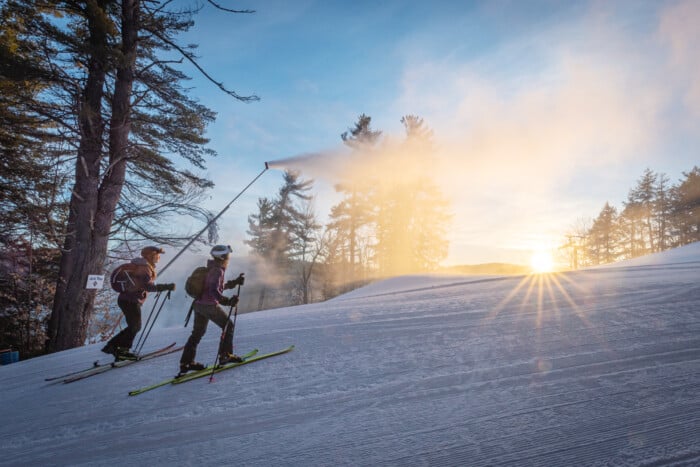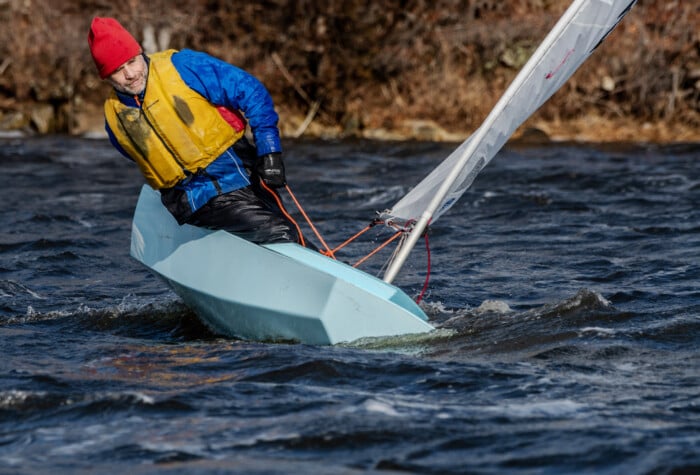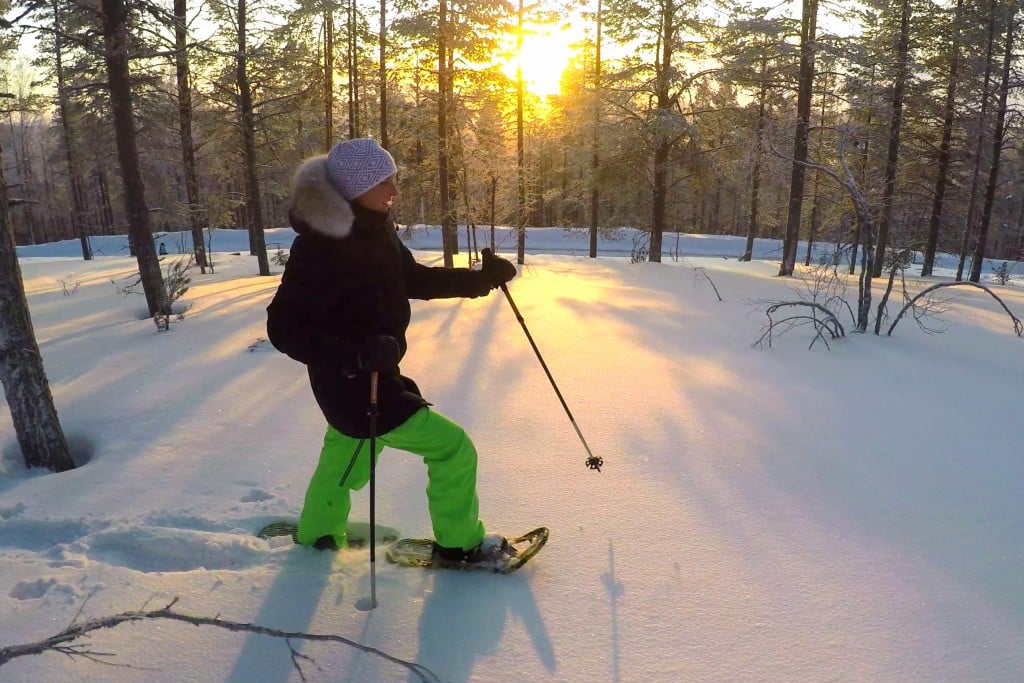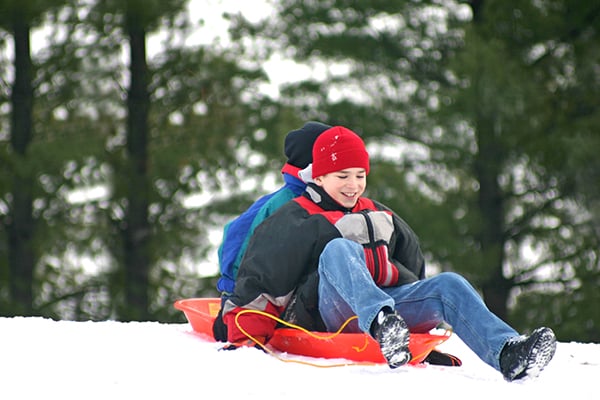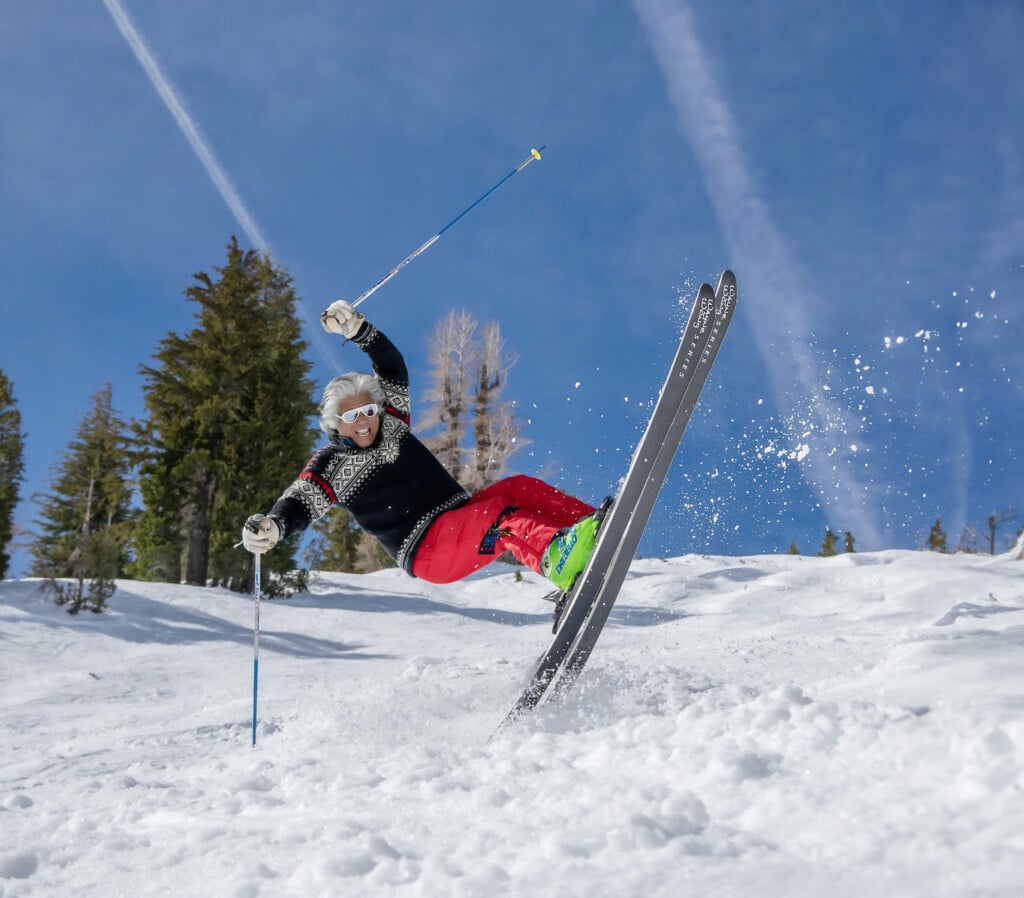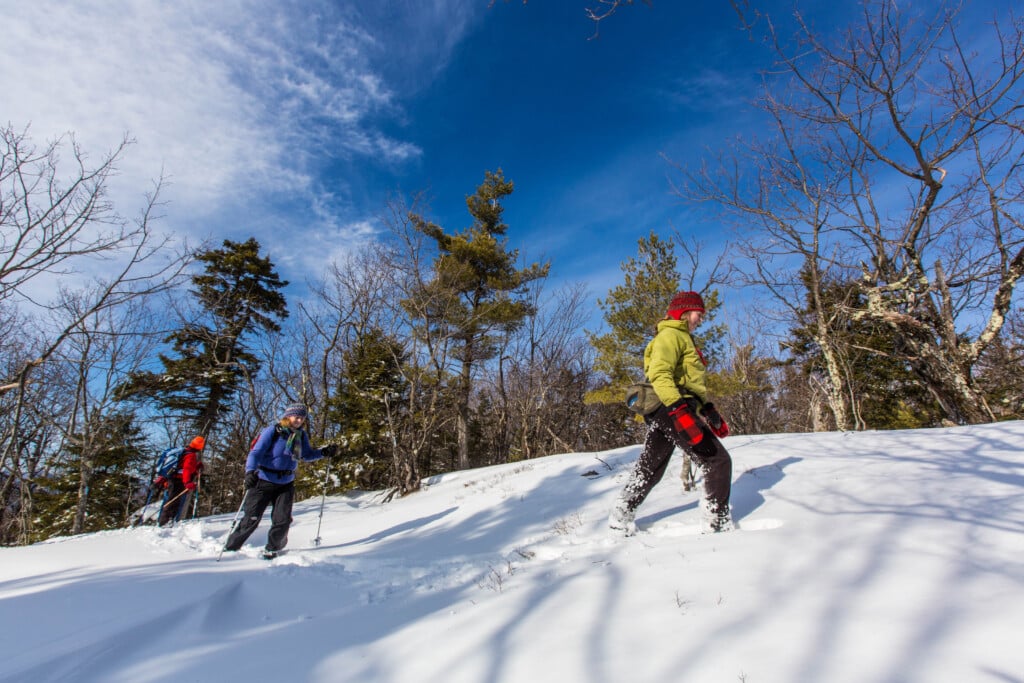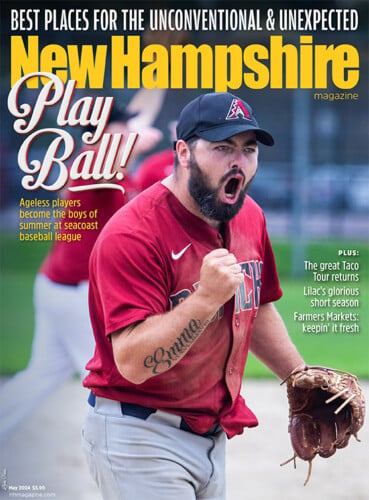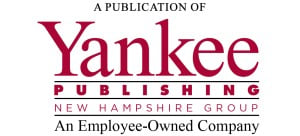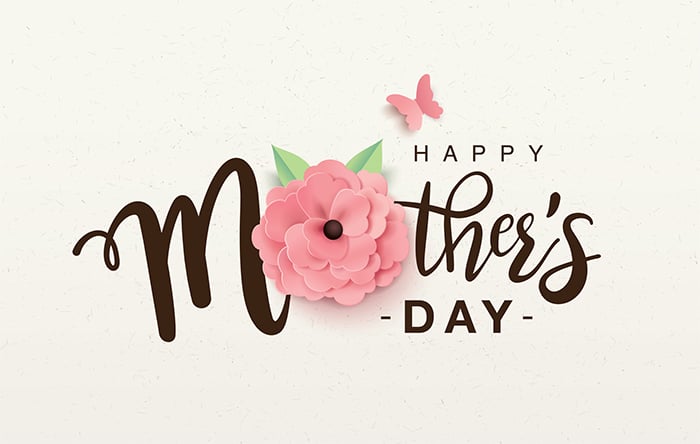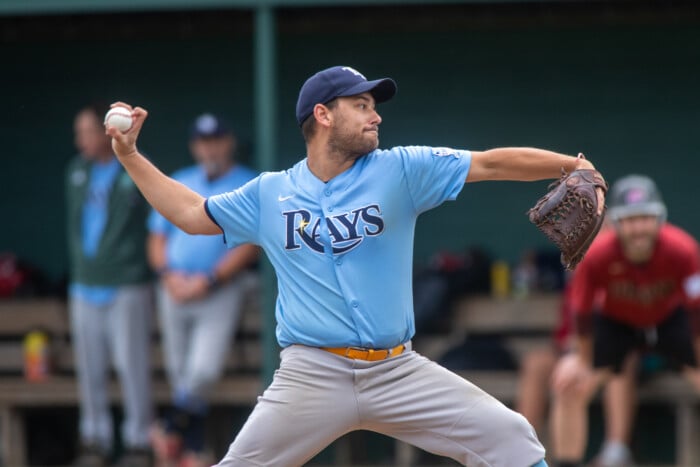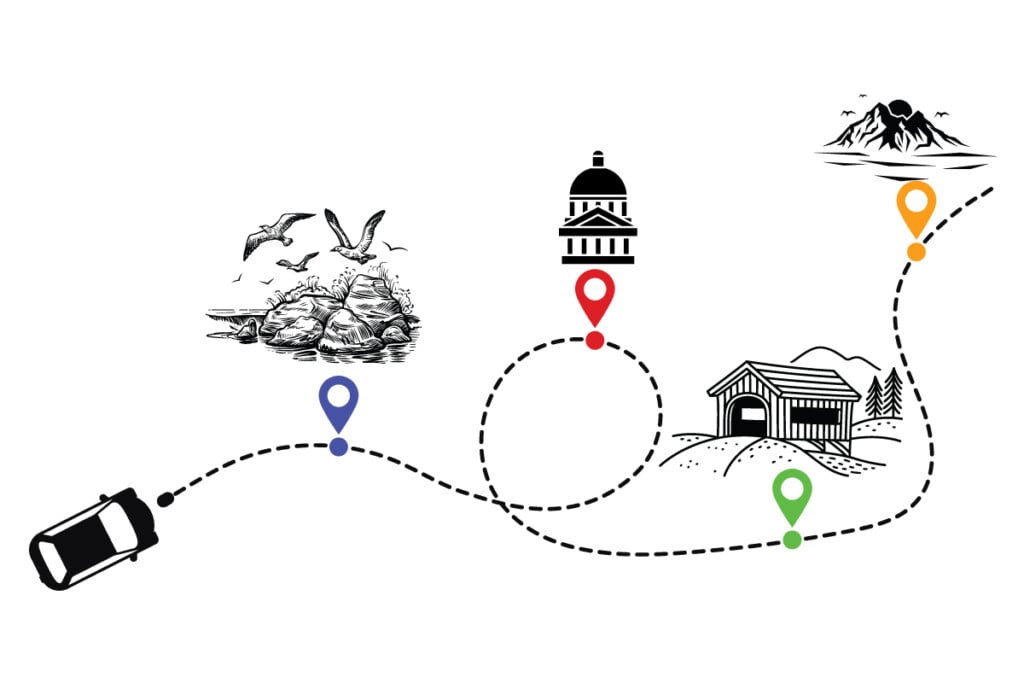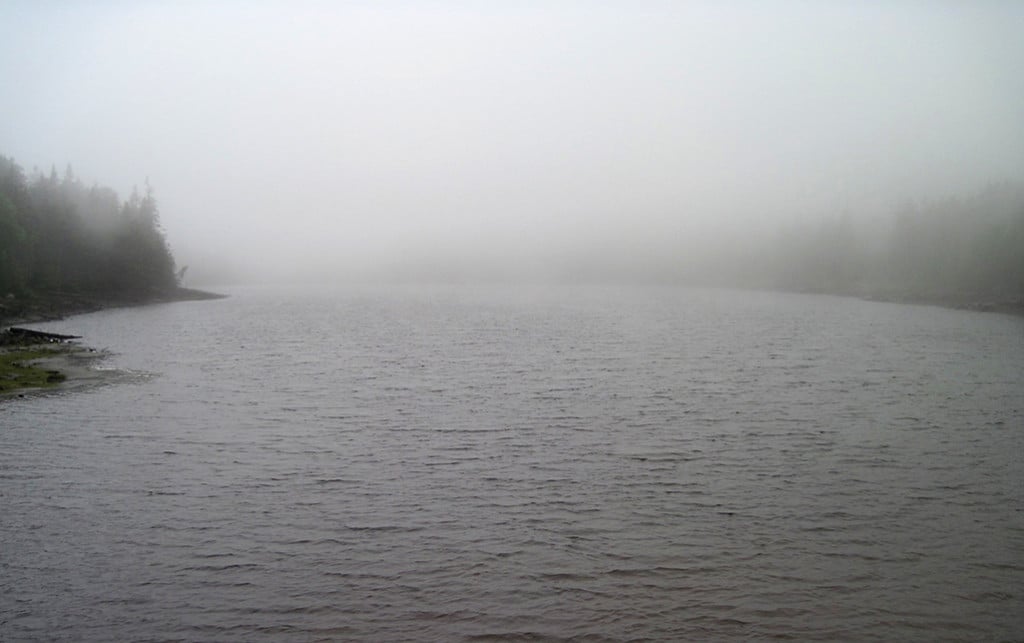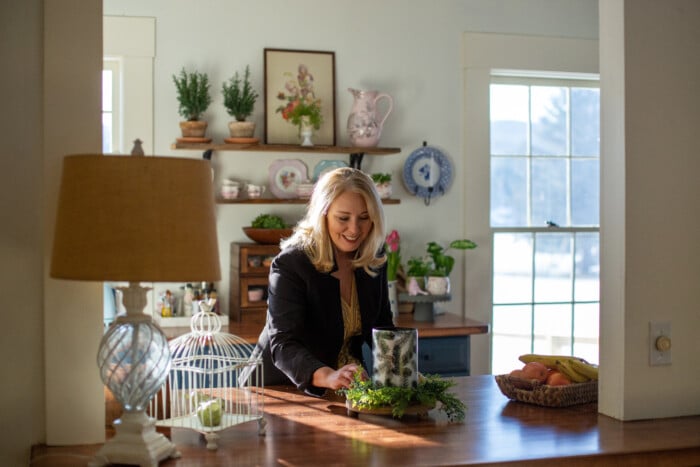How Mountains and Ski Areas in NH Are Dealing With COVID-19
Statewide ski areas and resorts are ready for you to enjoy winter fun, with COVID-19 safety protocols in place for the “new normal”

Though things might not look all that different on the slopes — such as at Waterville Valley pictured here — expect to see a number of changes this season at ski areas and resorts around the state. Photo by Tyler Walker/ Waterville Valley Resorts
Shortly after the onset of the COVID-19 pandemic last spring, experts encouraged people to get outside, into nature’s open spaces. They emphasized the myriad benefits of fresh air and sunshine for our mental, emotional and physical well-being. Normally, skiing — both alpine and Nordic — would seem to check off all those boxes. But COVID-19 is having a negative impact on the skiing experience, in the lodges, in the lift lines, and on the lifts themselves. Of course, New Hampshire’s ski areas and resorts, large and small, are no strangers to negative impacts.
“Rightly or wrongly, we are total optimists in this business,” says Kris Blomback, general manager at Pats Peak for the past quarter century. “You have to be. Running a ski area 60 miles from the Atlantic Ocean has never been for the faint of heart.”
Years of unpredictable weather and fluctuating energy costs have cultivated generations of resilient ski area managers who have combined Yankee ingenuity and dogged determination to deliver a great experience, on the slopes or on the trails. And they’ll need that combination of skills once again.
“We’ve had ski seasons that have been gangbusters, and we have had seasons where we had to fight and claw our way through the entire season,” says Blomback. “We have had to reinvent how we do business on the fly. In the past, we were charged with filling the place up with people, and now we have to reimagine how we do business and still raise the critical amount of revenue that is needed to support the operation.”
The same approach applies to the state’s Nordic ski areas.
“We really are an industry of problem-solvers, and adaptation is our greatest strength,” says Ian Cullison, director of Waterville Valley’s Adventure Center. “I feel that we’re in an excellent position to make the most out of this situation and provide the public with a much-needed commodity — fun.” That said, ski area managers acknowledge that the current pandemic, which Dr. Anthony Fauci, director of the National Institute of Allergy and Infectious Diseases, anticipates impacting the country through 2021, is unlike any impediment they’ve faced before.
“The challenges are different in that they’re new,” says Ellen Chandler, executive director of Jackson Ski Touring Foundation. “We’re accustomed to having bad weather and economic downturns, and we have plans in the toolbox for counteracting them. But the pandemic interferes with our strongest asset — our ability to interact with people.”
Which begs the question: Exactly how are New Hampshire ski areas responding to the pandemic, especially during the upcoming winter, when The Old Farmer’s Almanac is predicting a banner snowfall? In short, both alpine and Nordic areas have embraced the many benefits of getting into the great outdoors, while identifying all the areas where congestion creates concerns.
“The ski industry is fortunate in the sense that we have so much open space for our guests to spread out,” says Brian Norton, vice president of operations at Loon Mountain.
“Imagine a movie theater that had 1,000 acres to spread their guests out on while still being able to see the movie.
“We plan to use our exterior space to our advantage,” says Norton. “We will likely open terrain in a different sequence. We will have an increased focus on getting more terrain and lodges open faster than ever before. We’re set up for success here with our team, and our continued snowmaking upgrades allows us to maximize our efficiency.”
Likewise, Jackson’s Chandler says Nordic areas have natural spacing allowing participants to play free of crowds. Yet these areas do tend to promote gatherings.
“Cross-country skiing is usually a wonderful combination of social distancing — just you and your glide out in nature — and face-to-face socializing and learning with like-minded individuals, from in-depth discussions with instructors, guest service staff, rental shop staff and fellow skiers,” she says. “We’ve still got as much glide as you want, and experienced skiers will be OK for a year on their own,” she adds.
“What’s more challenging is how to provide positive introductory experiences for new skiers, and we’re working on that,” says Chandler. “We’re going to provide them with as much one-on-one as we can, but face-to-face will include some video, online, more on-phone and 6-feet-back spacing.”
According to Pats Peak’s Blomback, “The skiing component is the least of our concerns,” he says.
“We have to pay real attention to what I call the funnel effect,” Blomback adds. “You can have thousands of people spread out over your terrain, but eventually those folks need to go to the bathroom, eat lunch, interact with guest relations. It’s those areas that we have had to mitigate.”
Those mitigation efforts include increasing bathroom capacity, including placing additional temporary outhouses in parking lots (“We are encouraging people to use their car as a ‘personal base lodge,’” says Blomback), increasing outdoor seating at every dining facility and including to-go windows, and streamlining the ticket purchase process, including an emphasis on online options and hands-free kiosks.
“We’re looking at adding additional food areas and food trucks, and we’re are trying to improve the ‘tailgate’ experience as much as possible,” says Blomback. “We’re also looking into the possibility of maybe renting out portable pop-up tents, fire pits, et cetera.”
At the state’s Vail Resort properties — Mount Sunapee, Wildcat, Attitash and Crotched Mountain — Vail CEO Rob Katz told season passholders that face coverings will be required to access the slopes and “in all parts of our operations, including in lift lines, and while loading, unloading and riding in lifts and gondolas,” he wrote.
“To allow for physical distancing, we will be managing access to our mountains through a reservation system and limiting lift ticket sales in order to prioritize our passholders,” added Katz. “For the vast majority of days, we will be able to accommodate everyone who wants to visit. But this helps us ensure we can keep guests safe no matter when they come.”
Areas and resorts are also doubling down on staff training to make sure all their employees are on the same page.
“It starts with safety for the staff, and you need to look at your overall operation through that lens,” says Blomback. “If your employees don’t feel safe, then the rest of the business plan is a nonstarter. Safe to say we have had massive buy-in from our team in how we operate the facility.”
Similarly, Benjamin Wilcox, president of Cranmore Mountain Resort, says, “We are adapting our fall training to address operating during a pandemic. Priority number one is to put protocols in place so your staff feels safe.”
Many ski areas shuttered operations early last spring due to the pandemic’s sudden arrival. However, during the summer season, skis areas, especially those that offer lift-serviced mountain biking and sightseeing, such as Cranmore and Loon, have been able to conduct programs as a dry run to prepare the staff for the winter season.
“What happened last spring happened so fast,” says Loon’s Norton. “We certainly learned some things at the time, but where we have really gained the most knowledge is by operating this summer. After opening for summer operations, we were having nightly meetings to tweak and adjust operations, lift lines, traffic flows, based on what we learned that day,” he says. “It was incredible to see how fast our team was able to adapt and change based on the lessons we were learning hourly. That mantra has stuck with us.”
Similarly, Cranmore’s Wilcox says that “changing our products from ‘show up whenever you like’ to ‘block time period selling’ has helped us spread out people and assure social distancing.”
He adds that they’ll continue to use block-style selling at their popular tubing park in winter. “For skiing,” he says, “we know lodge traffic will be our biggest challenge. We’ve entertained the idea of reservations for food and beverage access.”
At Waterville Valley’s Adventure Center, Cullison says, “The biggest lesson we’ve learned this summer is that it’s important to establish clear expectations with guests. We’ve produced some creative signage to help all our visitors understand how to move through our spaces and participate in activities safely.”
Ski areas have also found a willing and motivated partner at the state capital in Gov. Chris Sununu, the former CEO at Waterville Valley Resort, who still has an ownership interest in Waterville Valley Holdings. Wilcox served on the governor’s Office of Emergency Relief and Recovery Stakeholder Committee this past spring and summer.
“Most of our work was to identify sectors that were greatly impacted by COVID-19,” Wilcox says. “Governor Sununu has done a great job handling this crisis, and it’s nice having a governor that understands the ski and tourism industry.” Blomback says he’s buoyed by Sununu’s can-do attitude.
“Governor Sununu is an optimist, and that’s what we love about him,” he says. “His family was very bullish on Waterville Valley and you can see the effort, care and capital that is being poured into the place,” says Blomback.
“His office has been very proactive and careful in reopening parts of the economy,” he adds. “Since skiing is a predominately an outdoor sport, he was bullish that it can be offered safely.”
Loon’s Norton reserved special praise for his colleagues in the industry, and the Ski NH association (which represents 33 alpine and cross-country areas), with taking an “all boats rise with the tide” approach to tackling the pandemic.
“Ski NH and the partner resorts have been a huge asset,” he says. “We can bounce ideas off each other and provide feedback on failures and successes along the way. This group has been in frequent contact with the state officials and has helped put the guidance in place for our summer operations.”
Moreover, Jessyca Keeler, Ski NH’s executive director, says “the industry is tight across the country, and we’ve had the privilege of working with the National Ski Areas Association and other state associations to share and learn from each other and our resort members.”
In addition to the physical adjustments being made by ski areas, public awareness and cooperation will be enormous factors in keeping those areas open and operating safely, says Peter Disch, general manager of Mount Sunapee Resort.
“The biggest challenge for everyone is going to be maintaining a high level of focus on safety and not to become complacent about it, especially as the situation improves,” says Disch. “We will all need to remain vigilant to ensure we continue an upward trajectory.”
To accomplish that goal, areas are getting the message out via a number of avenues, including social media campaigns and increased signage.
“We will have to use every communication tool in our kit this winter — email, mobile apps, signs, the Health & Safety page on our website, in-person conversation — whatever it takes,” says Norton. “We will be spreading our message with everything we have.”
Cullison says the Waterville Valley staff has created signs, featuring the resort’s moose mascot, reminding guests of the importance of wearing masks, washing their hands, social distancing, practicing “safe sneeze and cough etiquette,” and staying home if they’re not feeling well.
“We believe that the success of this season will rely on all of us being patient, kind and respectful to one another,” he says. “If we all do our part now by wearing masks and following recommended guidelines, the better chance we’ll have for a successful winter season.”
Even though snow has yet to fall (at least as of press time), Cullison’s staff was busy getting the message out. “To alert our guests, the marketing team has been making regular updates to our website, social media pages, and sending email campaigns as new information becomes available,” says Cullison. “We also have signage up resortwide to help set the tone for what visitors can expect during their time in the valley.”
Across the Kancamagus Highway to the east, the Mount Washington Valley has launched a “Mind Your Manners” communication campaign (see sidebar) “after crowds of people descended on the mountains this summer,” says Marti Mayne, public relations manager for the Mount Washington Valley Chamber of Commerce.
“This kind of messaging will continue through initiatives in partnership with the six chambers in New Hampshire’s North Country,” says Mayne.
The overwhelming majority of medical experts and scientific researchers agree with Dr. Fauci that the battle against COVID-19 is a marathon, not a sprint. It may be years before life returns to some semblance of normalcy. Ultimately, the reality of whether ski areas stay open, or are forced to shutter operations, rests with the very people who hope to enjoy these activities.
“I would just ask that skiers and riders — whether they’re veterans of the sport or new to it this year — be patient with our ski areas and staff and respectful of the changes we’ve had to make in order to be open,” says Ski NH’s Keeler. “No one wanted to have to make the kinds of changes that are being made, but more importantly, we do want to have a ski season. As such, we’re all going to have to make some sacrifices in order to make that happen.”
Regional businesses feeling the same crunch as ski areas
The harsh reality of the COVID-19 pandemic is that it’s pervasive, due in large part to one of the virus’s most frightening traits — a high transmission rate. The virus goes where people go. It doesn’t recognize town lines, county lines or state lines. It is ubiquitous, which means ski areas and resorts need help from local communities and visitors to combat the pandemic effectively.
That’s a key reason why ski hills and Nordic tracks are working closely with area businesses — retailers, restaurants, lodging accommodations — as well as visitors and government officials, is to ensure the measures they’re implemented on the snow are mirrored throughout the state. The bottom line is that everyone is in this together.
“The Mount Washington Valley is a resilient community,” says Marti Mayne, public relations manager for the Mount Washington Valley Chamber of Commerce (MWVCC).
“We’ve gotten through the past six months [as of September] and are adjusting to the challenges via messaging and working in partnership with northern New England chambers, Ski NH and White Mountains Attractions. Together, we’ll remain vigilant to keep our communities the safe haven they’ve been so far,” says Mayne.

Part of the Mount Washington Valley Chamber of Commerce’s “Mind Your Manners” campaign
North Country residents, officials, businesses and visitors all saw the “ripple effect” of the pandemic firsthand. Ski areas closed abruptly, and restaurants, bars and many retail outlets shuttered. When the initial springtime “lockdown” recommendation was lifted, people rushed outside, often ignoring precautions such as mask use and appropriate distancing. The MWVCC’s “Mind Your Manners” campaign was launched last summer in response to the subsequent “bad behavior” by residents and visitors.
In an official MWVCC release, officials wrote: “From parking lots to recreation areas, overcrowding is resulting in an abundance of trash, a disregard for parking regulations and social distancing requests, plus a lack of mask wearing and a general disregard for the community that has worked so hard to remain a safe refuge for its residents and avid outdoor adventurers that have traditionally come to recreate here.” Several popular spots, such as Diana’s Bath, were overwhelmed with illegally parked cars.
“Once the cars leave, a trail of trash and refuse remains,” officials wrote. “And this kind of situation is repeated in parking lots, roadsides and attractions throughout the Mount Washington Valley.”
With air travel limited, and accessible outdoor recreation destinations throughout New England in high demand, the pandemic resulted in more first-timers to the White Mountains of New Hampshire.
“We carefully crafted our way through a phased opening here in Mount Washington Valley,” says Janice Crawford, executive director of Mount Washington Valley. “The chamber took great care to be the best resource possible for the community and the visitors who come here.
“We’ve created signage reminding people to wear masks and placed signs throughout the valley reminding visitors to maintain a 6-foot social distance, and to respect our community,” says Crawford. “Yet, we continue to see and hear stories at the chamber about the general disregard for ‘good old American manners.’ It’s taken us all by surprise.”
Mayne says the “first-timer” trend is expected to continue this winter, so education is an important component to any approach to the pandemic. “We’ll see a younger traveler, and probably more people trying skiing for the first time. With homeschooling and remote working continuing, people are eager to get out of the house and into the mountains,” says Mayne. “If they’re not already skiers, snowboarders, cross-country skiers, snowmobilers, or outdoor hikers, they may just consider trying it for the first time. This could be a boon for cross-country skiing and snowshoeing — the perfect social-distance activities.”
Those numbers will rely on the ability of local businesses to remain open and profitable. Crawford and other North Country officials, including the Conway-based Ski NH association (which represents 33 downhill and Nordic ski areas) and the Cross Country Ski Areas Association, have engaged state officials to guarantee a true statewide effort to keep all businesses afloat.
“We are currently working with members of the administration and the Department of Public Health to develop opening guidance for ski areas,” says Jessyca Keeler, Ski NH’s executive director.
Keeler says Gov. Chris Sununu’s ski area management background helps, as does Department of Business and Economic Affairs Commissioner Taylor Caswell, an avid skier “who understands where the potential pinch points are at ski areas and can work with us on coming up with solutions,” she says.
Those solutions, at a minimum, will likely be developed using state-issued guidelines and precautions as parameters. Caswell, a key member of Gov. Sununu’s Reopening Task Force, announced a “business help portal” (businesshelp.nheconomy.com) developed by the Department of Business and Economic Affairs last May to keep everyone up to speed.
“Ensuring consistent and timely answers to questions from the business community, municipalities and all Granite Staters is very important,” says Caswell. “Our business help portal is a great tool to get clarity and further information on state-issued industry guidance. Governor Sununu has made a strong commitment to work collaboratively with the business community and municipalities to ensure that industries are able to reopen in a safe manner, and this is a tool to give them confidence to do so.”
